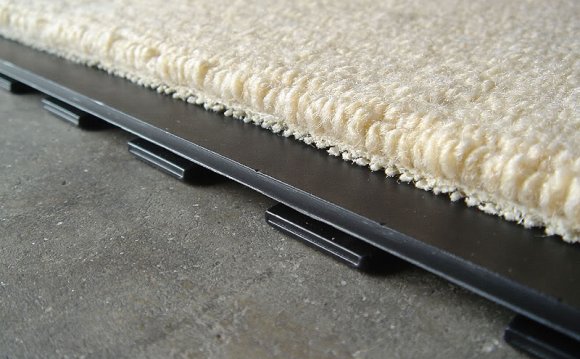
If you spend any time in your basement, it's likely you've had to deal with moisture problems at some point. Some of those issues can be solved as easily as running a dehumidifier during times of heavy rain or high humidity. For others, it's a persistent problem that not only leaves pools of water on your basement floor, but can cause thousands of dollars in damage to flooring, furniture and other possessions.
Basement moisture can be caused by a variety of factors including floods, roof runoff, condensation and permeation.
Most basement foundations are made of concrete. Concrete, while extremely durable and readily available, does have its flaws. One of which is its porous nature. Concrete allows water vapor to permeate through it. This becomes especially troubling as concrete ages and begins to crack.
The problem with basement moisture
Hardwood and fiberboard are generally discouraged as a basement flooring option as they will absorb moisture, expand, warp and rot. They also harbor mold and mildew, creating a hazardous environment for your home and family, tainting air quality and possibly causing structural damage. Flooring made with organic materials will need to be replaced in the event of flooding or persistent moisture.
Keep in mind that just because a flooring material may be waterproof, it doesn't necessarily mean that it is fit for use in wet areas. Some waterproof flooring may not be damaged by water or moisture, but may trap water underneath the floor if not installed correctly. This can create the same mold and mildew issues as wood and carpeting.
Solutions
There are several methods of battling the problem of basement moisture, including landscaping, creating vapor barriers and raised floors. While proper landscaping can direct rain water away from your house, it doesn't always solve the problem of water vapor. In extreme cases, such as flooding, a sump pump may be a necessity. Vapor barriers typically involve sealing your concrete walls and/or floor with coatings of paint or adhesives. It can also involve large sheets of felt or plastic.
Why Raised Flooring?
Raised flooring prevent moisture from becoming trapped, by creating a gap between your flooring and the concrete. Air flows under the floor allowing the moisture to dissipate without having to remove your flooring at each occurrence of moisture buildup. Who has the time to check for trapped moisture on a regular basis?
One of the simplest ways to create a raised floor is to purchase flooring tiles designed just for that purpose. Most of these tiles feature a waterproof plastic base with holes or channels that allow for air movement. Some even offer a perforated top that permits air flow horizontally and vertically. Most raised floor tiles also have some form of interlocking system that will allow for easily installation, removal and re-installation without damaging the flooring. Below we'll identify some of the top forms of raised floor tiles you can use to convert your damp basement into a home gym, family room or kids play area.
Carpeted family room
If you are set on turning your basement into a carpeted family room, but fear the moisture will cause problems, raised carpet tiles are your answer. You'll want to find a raised carpet tile with a waterproof base material and preferably a waterproof carpet fiber as well. Greatmats offers a raised carpet tile called CarpetFlex Floor Tile that features a polypropylene base topped with a polyolefin ribbed carpet. The carpet top is environmentally friendly, chemically resistant and won't decompose in wet environment. It is made of the same materials as active wear, known for the ability to transport moisture away from the body. Meanwhile the waterproof raised base keeps the carpet out of standing water, giving you the ideal carpeting system for your basement.









